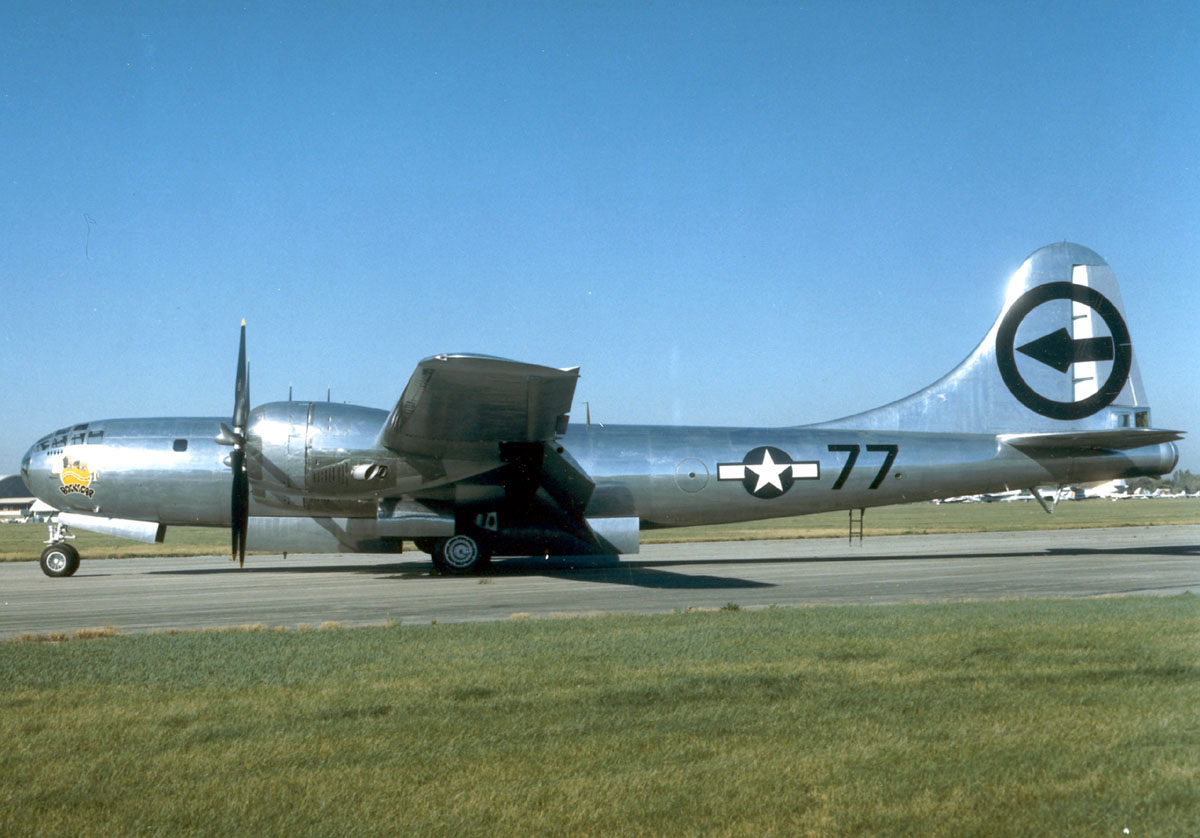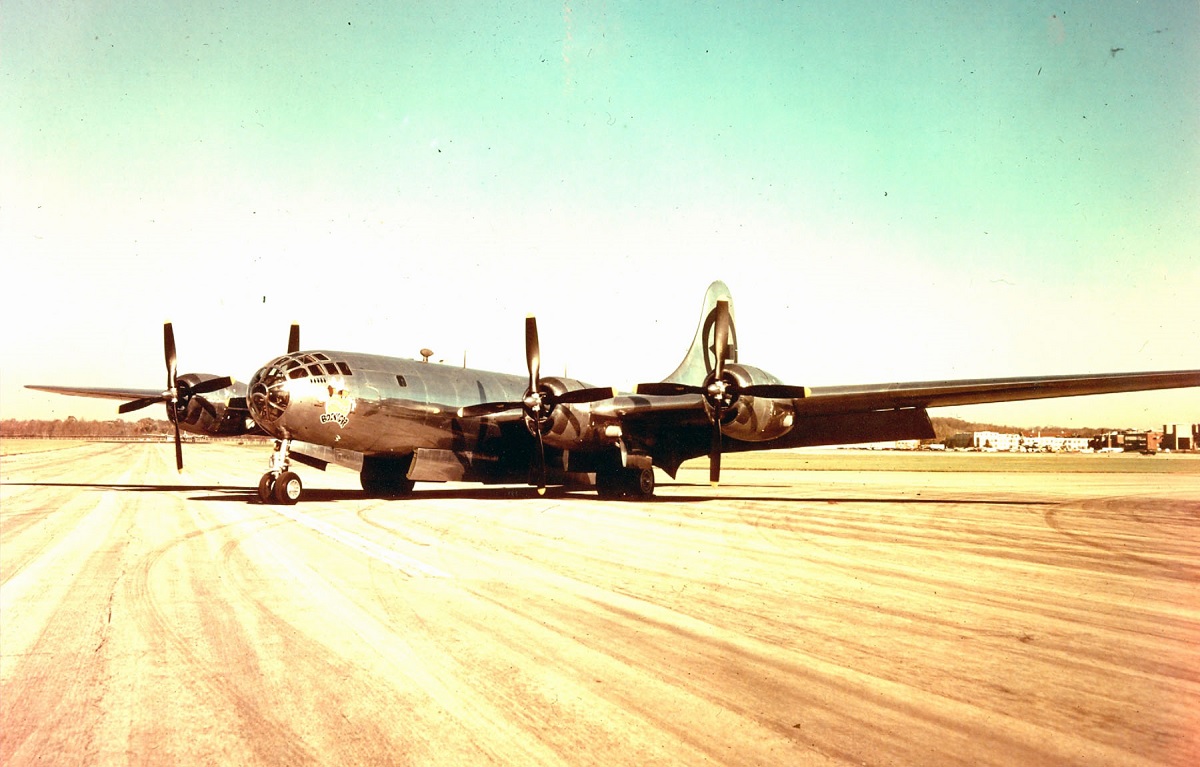LeMay made the decision to turn to low-altitude incendiary operations after the high-altitude B-29 bombing with high-explosive ordnance produced negative results
Although General Douglas MacArthur is regarded as one of the greatest leaders of World War II and the 20th century as a whole, his command of the USAAF’s second-largest air force is sometimes overlooked.
Following the Japanese’s humbling defeat in the Philippines in 1942, MacArthur and his air chief General George Kenney were adamant about reestablishing the US aerial presence in the Pacific. The Allied naval and ground troops fought valiantly to drive the Japanese Air Force back, reclaim the Philippines, and advance the fight northward toward the Home Islands, and this increasing force was essential in assisting them. Yet the B-29 force was never tactically under MacArthur’s control.
The Boeing B-29 Superfortress was not only the pinnacle of strategic airpower in World War II but also the tool employed to carry out the strategic air campaign that would ultimately prove crucial in the downfall of Imperial Japan, as Bill Yenne explains in his book MacArthur’s Air Force.
Chester Nimitz and Douglas MacArthur were briefed on the B-29 by General Hap Arnold, the USAAF’s commanding general, and both of them expressed a desire for tactical control of the aircraft inside their respective regions.

Arnold believed that the operational control of the superweapon should be in the hands of someone who had an eye for the ultimate strategic purpose as opposed to someone focused on a specific set of tactical goals inside a theater of operations. Additionally, Arnold was committed to using his most extreme kind of strategic airpower solely for that mission—to defeat Japan by attacking Japan.
So he decided to personally keep command of the B-29 force from his seat on the Joint Chiefs of Staff. The USAAF Twentieth Air Force, which was established in April 1944 and was under Arnold’s direct command, would receive the entire operational Superfortress fleet. Arnold said in his memoirs, “I could do nothing but retain command of the B-29s myself.” He went on:
“I could not give them to MacArthur because then they would operate ahead of Nimitz’s command; I could not give them to Nimitz since in that case, they would operate in front of MacArthur’s advance. So, in the end, while everybody wondered why, I kept the personal command of the Twentieth Air Force. There was nothing else I could do, with no unity of command in the Pacific. I could find no one out there who wanted unity of command, seemingly, unless he himself was made Supreme Commander.”
Kenney continued to lobby for B-29s on behalf of MacArthur notwithstanding this ruling. In January 1944, Kenney was in Washington, DC, and he informed Arnold, “I could destroy the oil refineries of the Dutch East Indies and the Japanese would be unable to keep the war going.”
He had written to Arnold asking to “let me change over my B-24 groups to B-29 outfits so that I could drop ten tons of bombs per airplane instead of four.”
Kenney recalled that Arnold replied that he “would not make any promises but said that if I had a runway big enough to take them by July, he might let me have 50 B-29s at that time.” Kenneynrecalled that he issued orders for “construction of a 10,000-foot runway at Darwin, with parking for a hundred B-29s.”

Darwin’s 10,000-foot runway was finished, but it would never be able to accommodate MacArthur and Kenneyndream’s B-29s. Arnold would dispatch his Superfortresses to China as opposed to Australia. Arnold was looking for a location where he could base his large bombers and be within striking distance of Japan. As China was the only option in the spring of 1944, Arnold moved to Chengdu, which was 2,200 miles from Tokyo and around 180 miles from Chungking (now Chongqing), the capital of Nationalist China at the time.
The B-29s’ first operational deployment was with the Twentieth Air Force’s XX Bomber Command, under the command of Major General Kenneth B. “KB” Wolfe. In his position as a production engineering specialist with the Air Materiel Command, Wolfe had been in charge of the Superfortress’s technical development. As Thailand was an ally of Japan and served as a route for supplies to enter Burma, the first raid was carried out on June 5, 1944, against Japanese facilities in Bangkok. Ten days later, Yawata was the target of the first mission against a target inside Japan. On July 7, a significant raid on Japan was conducted.
In August, dissatisfied with the slow pace of the XX Bomber Command operation, Arnold replaced Wolfe, the technician, with Major General Curtis E. LeMay, a tough, results-oriented leader who had been commanding the 3rd Air Division of the Eighth Air Force. In October 1944 LeMay commanded the XXI Bomber Command too which had absorbed XX Bomber Command assets.
LeMay made the decision to move to low-altitude incendiary missions as a result of the unsatisfactory results obtained from high-altitude bombing employing high-explosive ordnance. Because most of the Japanese industry relied on subassemblies produced in urban areas, burning out urban centers was a better approach to destroy the economy than attacking major industries, as had been done in Germany. The goal of strategic bombing is to destroy an enemy war economy by destroying the industry.
As LeMay told this author four decades later:
“I made up my mind to make some major changes in the way we were using the B-29s because it was now clear that we wouldn’t possibly succeed by basing our strategy on our experience from Europe. That system wasn’t working. It was a different war with different weather and different airplane. It called for a different solution. As I looked over the reconnaissance photos, I noticed that there wasn’t any low-altitude flak such as we’d encountered in Europe. It looked reasonable to me that we could fly a successful mission with less fuel and a larger bomb load by going in low, particularly if we went in at night. After sizing up the situation and knowing that I had to do something radical, I finally arrived at the decision to use low-level attacks against Japanese urban industrial areas using incendiaries.nEven poorly trained radar operators could find cities that were on or near the coast, and going in at between 5,000 and 8,000 feet instead of 25,000 feet would ensure that all the bombs would fall in the target area. This method solved the weather problem because, instead of getting the force ready and then waiting for the right weather, we would go in under the weather when we were ready.”

LeMay chose to overwhelm Japanese defenses with a series of missions involving a maximum amount of effort, each involving about 300 Superfortresses, as opposed to earlier XXI Bomber Command flights, which had averaged about 60 B-29s. These missions were carried out against Tokyo, Osaka, Kobe, and Nagoya at night between March 9 and March 20 until incendiary supplies were exhausted.
LeMay recalled:
“… it was April 13 before we had built up large enough stocks of incendiaries to support a full-scale mission, but we flew a lot of smaller-scale missions while we were waiting for more bombs. ThenNavy scurried around and got some ships, and in six weeks we had the bombs. We never caught up from then on, though. We simply bypassed the bomb dumps, and with the help of the Seabees, some Marines that were supposedly in a rest camp, and anybody else that was around, we brought the bombs from the supply ships directly to the hardstands of the airplanes. Soon we were dropping over 3,000 tons per mission.
“I was not happy, but neither was I particularly concerned, about civilian casualties on incendiary raids,” LeMay explained to Yenne candidly. He continued:
“I didn’t let it influence any of my decisions because we knew how the Japanese had treated the Americans — both civilian and military —that they’d captured in places like the Philippines. We had dropped some warning leaflets over Japan, which essentially told the civilian population that we weren’t trying to kill them, but rather that we were trying to destroy their capability to make war. We were going to bomb their cities and burn them down. We suggested they leave for their own safety.”
As American air force finally dealt critical strikes against the center of Imperial Japan, MacArthur and Kenney watched. Arnold did provide them a very heavy bomber, even though he never gave them the B-29. By the spring of 1945, the Consolidated B-32 was fully operational. The Fifth Air Force 312th Bomb Group became a “very heavy bombardment group,” and B-32s were sent to Clark Field on Luzon in June 1945.
MacArthur’s Air Force is published by Osprey Publishing and is available to order here.
Photo by U.S. Air Force and Tomás Del Coro from Las Vegas, Nevada, USA via Wikipedia

